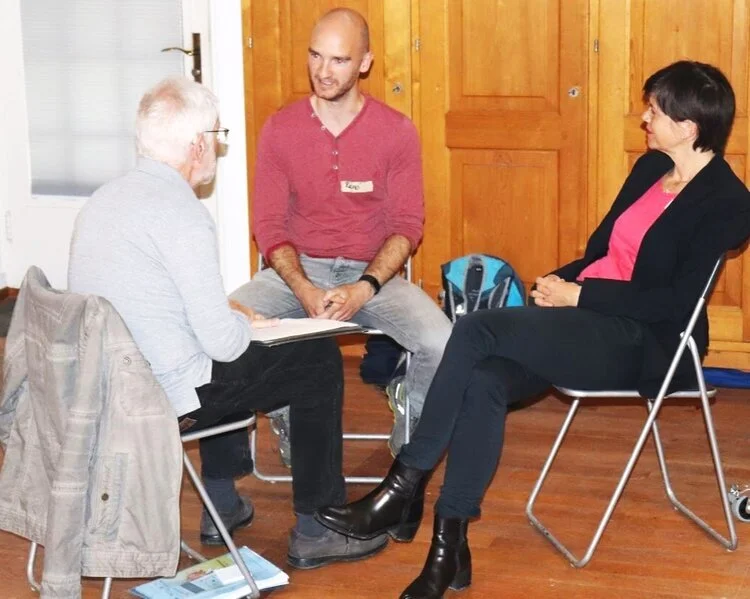Triads
Triads at Dialogue Evenings
Triads are a dialogue tool to share experiences and insights, witnessing and offering feedback in groups of 3. Triads are a format that allows participants to share experiences and insights in small groups of 3 while being witnessed by others and receiving meaningful feedback. As in any dialogue tool, the aim is to enter into an exchange with an open mind and heart, listening attentively, with respect and curiosity for other opinions, suspending our own judgments, and as a speaker sharing from the heart and with authenticity. Dialogue has the potential to shift how we relate to ourselves and to the others who are involved in the conversation and create a space that feels safe to express oneself and come to a more authentic way of being with each other.
Triads are a good tool to use in workshops or dialogue evenings whenever you wish a deeper reflection and sharing to happen in smaller groups.
Process
During the triads, there are 3 roles that each person holds by turns:
The speaker/storyteller: The person who shares her/his insights and experience in relation to the question(s). Generally in dialogue we encourage experience based sharing and speaking from the I (sharing something that I have experienced and how it has touched me, instead of sharing theoretical ideas and opinions on a topic).
The listener: The person who practices active listening. The listener can also ask deepening questions or comprehension questions if appropriate, yet in the first place the listener holds space for the speaker to explore the given question and share from her/his depths. It’s also good to allow for moments of silence.
The observer/witness: The observer is also listening, but with a different focus: What kind of images come up during the listening? What kind of emotions are present in the body? What do you observe in the body language of the speaker? What is the essence of that which has been shared? The observer can also take some notes or alternatively draw and offer it as a feedback. At the end she/he will share the impressions to the speaker.
What does the process look like?
Find a powerful question that you would like the participants to share on, and write it on a Flipchart.
Form groups of 3 (either by letting the participants freely choose two other participants they are less familiar with, or by letting the participants count to a certain number which allows to form groups of 3).
Let the groups find a spot in the room (the room should be big enough so that small groups can have relatively undisturbed conversations. The groups should not leave the room, so that they can hear the instructions of the facilitator).
Let the groups decide who will start (either let one person per group raise their hand, or you can also make an indication, e.g. “the person with the shortest hair will start”).
Read the question and make it visible on a flipchart so that the groups can always see it. Give an overview on the process and indicate how much time there will be for each speaker and each feedback (recommended around 7 minutes speaking time, and 3 minutes for feedback).
Let the first speaker start. Indicate that it is time for feedback after 7 minutes with the gong. After another 3 minutes, indicate with the gong that it is time for the next speaker. Continue until all 3 participants have spoken / had all roles.
Optionally, you can leave some time at the end for generative dialogue and open exchange on the experience in the groups of 3.
Optionally, you can continue with a second triad round on another question in the same group, or form other groups of 3.
Optionally, you can ask everyone to bring a key essence or a new insight of what they shared and received as feedback back to the big circle. In that way you can harvest the different threads that unfolded in the small groups.
Needed time and tools
Usually 30 minutes is a good timing for triads. If you would like to work on several questions, you can extend the time accordingly. Take into consideration that you will also need time to form the groups of 3 and until all the groups have found a spot in the room, so in total it’s recommend to plan 40 - 45 minutes for a triad session.
The room should be big enough so that small groups can have relatively undisturbed conversations.
Materials needed:
Flipchart with the prepared question(s)
Gong
Notebooks and pens or colored pencils
Sources and further literature
Sarah Friederich was part of the Catalyst Lab design and hosting team at collaboratio helvetica and in this role supported the implementation of the Sustainable Development Goals (SDGs). As a facilitator (Theory U, Art of Hosting, Dialogue) she supports diverse projects in the area of social innovation with design and facilitation of participatory events and group processes. The promotion of new forms of collaboration and systemic change are an integral part of her work. For many years, she has gained experience working for NGOs and social organisations in the field of environmental and social justice in Switzerland and Bolivia.
In addition to her work with collaboratio helvetica and as a facilitator, Sarah supports people as a coach in their personal development processes, especially in the process of grieving after the loss of a loved one.


